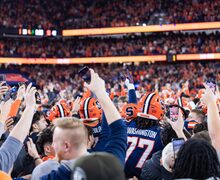MBB : Founding history: Formation of Big East forged, strengthened basketball rivalries
In an airport terminal more than a decade ago, Greg Ashford heard the future of the Big East. As he and his wife, Leslie, waited for their connecting flight from Charlotte back home to Connecticut following a vacation, he spotted Big East Commissioner Mike Tranghese.
The ensuing five-minute conversation between Tranghese and Ashford, a former assistant coach for the Connecticut men’s basketball team, told of the new direction for the conference.
‘I hadn’t seen Mike in a long time because I had been out of coaching. But I remember that he didn’t like to fly,’ Ashford said. ‘So here he is down in Carolina, and apparently, he had been down there talking to the schools in that area.
‘I remember the conversation just in passing about football, the mention that had surfaced. And so, apparently, football was becoming a prime driver now. So the conference had evolved in that direction.’
Though the exact year of the conversation eludes him, the mention of football by Tranghese remains poignant in Ashford’s memory. He spent eight seasons with the Huskies from fall 1978 to spring 1986 and witnessed the creation of the Big East conference in the process.
Providence, St. John’s, Georgetown and Syracuse extended invitations to Seton Hall, Connecticut and Boston College to create the original seven-team Big East on May 31, 1979. It was a league designed to bring together schools from the Northeast into a singular basketball-powered conference. Football wouldn’t become a part of the Big East until 1991.
‘Starting in the mid-1990s, that’s when football became — schools are starting to think big picture now, I guess,’ Ashford said.
Big picture seems to mean big money, and in the most recent shake-up to college athletics, Syracuse and Pittsburgh left the Big East for the Atlantic Coast Conference, a league with a more lucrative television deal and one that provides more financial stability for its members.
In doing so, the Orange leaves a conference that its head coach, Jim Boeheim, essentially built. Boeheim took over the reins for SU in 1977 and was instrumental in the formation of the Big East, along with legendary coaches John Thompson of Georgetown, Lou Carnesecca of St. John’s and the league’s commissioner, Dave Gavitt, who was the former Providence head coach.
The seven teams began play in the 1979-80 season, kick-starting an amazing run that catapulted the league to the top of the college basketball scene. By the time Syracuse — which won the inaugural conference championship — and Pittsburgh accepted offers to leave, the Big East had swelled to 16 schools and was considered by many to be the best basketball conference in the country.
Now, the Orange plays the role of lame duck until the move to the ACC becomes official within the next 27 months. Syracuse leaves behind some of the fiercest conference rivalries in all of college sports, namely its games against Georgetown and Connecticut, and a conference that catalyzed SU’s ascension to becoming an elite program.
‘It made us a national program,’ Boeheim said. ‘We were an eastern program, as was everybody else. And the league made us a national program and able to play for national championships. That’s what the Big East did. It was a great, great help for our program.’
***
By the time Roosevelt Bouie left Manley Field House the day before a game, the ‘Zoo’ had already arrived. Fans — mostly students — lined the walkways outside the arena to secure a ticket to the game. They camped out, hundreds of them, all disciples of the Orangemen.
‘It was like 17 below zero sometimes,’ said Bouie, a center for SU from 1976-80. ‘We’d leave practice, and they would be out there like the day before the game.’
The night of Jan. 4, 1980, was no different. A low temperature of around eight degrees meant nothing. The ‘Manley Zoo,’ as the overly enthusiastic student section was known, probably welcomed the chill, especially considering the magnitude of the next day’s game.
Saturday, Jan. 5, marked Syracuse’s grand entrance into the Big East. The ninth-ranked Orangemen hosted — and pummeled — a Seton Hall team in front of 9,258 crazed fans. The 99-76 win cemented SU as a contender in the fledgling conference and firmly established the role of Manley as one of the team’s greatest weapons.
‘On average it was the biggest, loudest group of fans,’ Bouie said. ‘And for the first Big East game, that was record-setting. Nobody wanted to play us in Manley Field House. It was so loud that it was scary sometimes.’
Ashford recognized the fear. While an assistant at UConn under head coach Dom Perno, Ashford said the Huskies were scared by Syracuse. When 1980 rolled around, six years elapsed since Connecticut knocked off the Orangemen.
‘We were intimidated by Syracuse, that was my perspective,’ Ashford said.
Yet in the first year of the Big East, that all changed. When the Huskies entered Manley on Jan. 26, they didn’t believe SU was the dominant machine that trounced them by 40 points two seasons earlier.
UConn hung tough, but ultimately lost 99-89. A year later, the Huskies beat the Orange twice in the regular season.
The rivalry was born.
‘That year in Manley, we finally got over our jitters,’ Ashford said. ‘We saw them as no different than anyone else. … They were talented the following year, but our guys came to play, and that was the turning point. That was fantastic. I have to say that was a highlight.’
***
Georgetown was too confident for fear. Despite SU’s 57-game home winning streak, the Orangemen’s No. 2 national ranking and the raucous ‘Zoo,’ the Hoyas strode into Manley on Feb. 12, 1980, unfazed.
The final game to ever be played at Manley went down to the wire. It was senior night for Bouie and teammate Louis Orr, who together formed the ‘Bouie ‘N Louie Show’ on the court. Bouie led the team in scoring that year with 16.1 points per game. Orr grabbed the most rebounds for the Orangemen.
Though Georgetown was unranked, SU’s senior class had never beaten the Hoyas, meaning this was their last chance to do so at home. And Georgetown let them know it.
‘They knew that if we ever beat a Maryland or Syracuse, John Duren (a three-time All-American guard for the Hoyas from 1978-80) would call the opposing players on the phone and make jokes at them and crack jokes about them,’ former Georgetown forward Craig Shelton said. ‘He would do that a lot.’
But in Bouie ‘N Louie’s final home game, it was a freshman who left them stunned.
Eric ‘Sleepy’ Floyd, a 6-foot-3, 170-pound guard, hit two free throws with five seconds left to give the Hoyas a 52-50 win. Streak over. Manley closed.
‘At that time, I didn’t know the magnitude of what was going on,’ Floyd said. ‘But looking back on it, that was a historic moment in the Big East. And that rivalry between Syracuse and Georgetown just really took off from a national level.’
***
John Toner called Perno, Ashford and Jim O’Brien, the other UConn assistant coach, into his office in 1979 with an offer. Toner, then the athletic director at Connecticut, presented his basketball staff with a mandatory invitation.
‘He had presented to us basically an invitation to be in the Big East,’ Ashford said. ‘And for us, after we left that meeting, we felt that we had no choice but to join because it was going to be a great opportunity.’
Thirty-two years later, Daryl Gross was in Toner’s shoes. The Syracuse athletic director called a coaches meeting with his entire staff to discuss the school’s move to the ACC.
Just as UConn had felt obligated to accept, so too did Gross in 2011.
‘Obviously, very empathetic to the Big East, you know,’ Gross said. ‘And I’ve been here seven years, I have a lot of colleagues there, and we understand it. But at the same time, the opportunity for the ACC is one that you just can’t second-guess yourself on.’
Gross described the demeanor of the coaches as ‘fired up’ during that meeting. ‘Just back flips,’ he said.
Boeheim wasn’t at that meeting. He was out recruiting. The face of Syracuse basketball and a Big East lifer, Boeheim’s reaction to the move was quite different.
‘The chancellor has to make the decision based on what’s best for the university, and she did that, and I’m very comfortable with that,’ he said.
Best for the university doesn’t necessarily mean best for Syracuse’s highest-grossing revenue sport. Though Boeheim did say rivalry games with Georgetown and St. John’s are likely to continue as nonconference matchups following the move to the ACC, that doesn’t mean the former participants are satisfied.
Sleepy Floyd was ‘shocked’ to hear Syracuse and Pittsburgh were jumping ship. He couldn’t imagine the Big East without the Hoyas-Orange rivalry that has entertained the country for so many years.
‘It’s very sad when I heard that Syracuse was leaving the Big East and going to the ACC, basically being driven by football dollars,’ he said. ‘ … That is a sad state of affairs in America.’
Eric Devendorf, an SU guard in the late 2000s, is convinced Boeheim would have rather stayed in the Big East. He gives the coaching mogul ‘a year or two’ in the ACC before he retires.
As Syracuse and Pittsburgh depart, the future of the league itself is in jeopardy. Though 14 basketball schools remain, the conference is left with only six football schools. And as Floyd pointed out, football and money are the driving forces of the conference at this point.
On the day rumors about SU and Pitt defecting first surfaced in the national media, Dave Gavitt, one of the founders of the Big East and the league’s first commissioner, passed away. Two days later on Sept. 18, those schools officially moved on.
‘It’s something that over time, I saw it happening,’ Ashford said. ‘And at this point in time, I can see really clearly why. Football was in the mix.
‘ … And my thought was that Dave, the genius behind the Big East, had died. And maybe, hopefully, the Big East doesn’t die as well.’
Published on October 11, 2011 at 12:00 pm
Contact Michael: mjcohe02@syr.edu | @Michael_Cohen13





